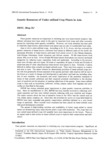Genetic Resources of Under-utilized Crop Plants in Asia
JIRCAS international symposium series
| ISSN | 13406108 |
|---|---|
| NII recode ID (NCID) | AA1100908X |

Full text
intlsymp-2_19-24.pdf248.97 KB
Plant genetic resources are important in initiating any crop improvement program. Significant advances have been made in the past in important food crops and other economic species by exploiting useful genetic variability. However, not much attention has been paid to relatively lesser-known, underutilized crop plants that are also of considerable food value. Asia is rich in under-utilized crops. According to Dr. R. K. Arora, who has reviewed the genetic resources of lesser-known cultivated food plants in different parts of the world, the maximum diversity of lesser-known cultivated food plants occurs in the Chinese-Japanese, Indo-Chinese, Indonesian, South American and African centers. Of 990 lesser-known food plants, 36% occur in Asia. Arora divided 900 lesser-known food plants into several use-based categories viz. tuberous types, vegetables, fruits and seeds/nuts. According to his account, there were 48 tuber and root types, 135 kinds of vegetables, 30 types of fruits and 33 kinds of seeds/nuts plus 57 other miscellaneous lesser-known food plants in Asia. However, it seems difficult to define what actually are lesser-utilized crops. They vary from country to country and area to area. The major criteria for determining priorities of lesser-utilized crops are: the risk that genetically diverse material of the species and their wild relatives will be lost in the future as a result of change and development in agriculture and land use, including adoption of new varieties; the economic and social importance of the materials measured in terms of their present usefulness and their expected potential contribution to the development of mankind and the situation of existing collections of the species. Some lesser-utilized crops in Asia such as buckwheat, safflower, millets, sesame, minor food legumes and amaranths are described in this paper.
IBPGR has always attached great importance to plant genetic resources activities in Asia. Since its establishment in 1974, IBPGR has been heavily involved in collecting cultivated materials and then later shifted towards collecting wild crop relatives and forages. The major concern about the loss of primitive forms in the 1970 s was for cereals such as rice, wheat, maize, sorghum, etc. Since then, the priorities for action on crops determined by IBPGR have been expanded and genetic conservation activities initiated on a very broad range of materials. More recently much emphasis has been placed on lesser-utilized crops with good development potential.
The spread of high-yielding varieties and availability of better types suited to varied tastes are threatening many lesser-known native crops with extinction. The crops that are now called lesser-utilized crops will possibly have more importance in the future. There is an urgent need to take action on lesser-utilized crops to improve their conservation and utilization.
IBPGR has always attached great importance to plant genetic resources activities in Asia. Since its establishment in 1974, IBPGR has been heavily involved in collecting cultivated materials and then later shifted towards collecting wild crop relatives and forages. The major concern about the loss of primitive forms in the 1970 s was for cereals such as rice, wheat, maize, sorghum, etc. Since then, the priorities for action on crops determined by IBPGR have been expanded and genetic conservation activities initiated on a very broad range of materials. More recently much emphasis has been placed on lesser-utilized crops with good development potential.
The spread of high-yielding varieties and availability of better types suited to varied tastes are threatening many lesser-known native crops with extinction. The crops that are now called lesser-utilized crops will possibly have more importance in the future. There is an urgent need to take action on lesser-utilized crops to improve their conservation and utilization.
| Creator | ZHOU Ming-De |
|---|---|
| Publisher | Japan International Research Center for Agricultural Sciences |
| Available Online | |
| Issue | 2 |
| spage | 19 |
| epage | 24 |
| Language | eng |
